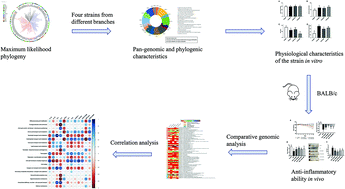Identification of the key characteristics of Bifidobacterium longum strains for the alleviation of ulcerative colitis†
Abstract
Bifidobacterium longum (B. longum) species are widely used to prevent and treat ulcerative colitis (UC). In this study, phylogenetic and pan-genomic characterization of 122 B. longum strains was performed on the basis of 936 core genes; among these, four strains from different branches of the phylogenetic tree were selected for an evaluation of anti-inflammatory and immune modulatory activities in a DSS-induced colitis mouse model. Among the tested B. longum strains (B. longum FBJ20M1, B. longum FGDLZ8M1, B. longum FGSZY16M3, and B. longum FJSWXJ2M1), B. longum FGDLZ8M1 was found to most effectively alleviate colitis by reducing the expression of pro-inflammatory cytokines, restoring the colon length, and maintaining the mucosal integrity. The anti-inflammatory mechanisms of B. longum FGDLZ8M1 were related to the inhibition of NF-κB signaling. Genomic analysis indicated that these protective effects of B. longum FGDLZ8M1 may be related to specific genes associated with carbohydrate transport and metabolism and defense mechanisms (e.g., tolerance to bile salts and acids). Correlation analysis indicated that gastrointestinal transit tolerance was the most strongly associated factor. Our findings may contribute to the rapid screening of lactic acid bacterial strains with UC-alleviating effects.



 Please wait while we load your content...
Please wait while we load your content...